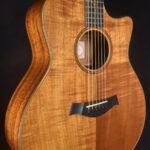Origin: The Big Island of Hawaii
Used On: The Koa Acoustic and Acoustic/Electric Series
As a tropical hardwood, a koa top will initially project a bright and focused tone, especially together with koa back and sides, but as it’s played, it matures into an increasingly warm, rich, sweet sound with healthy overtone “bloom,” especially in the midrange. A common mistake is when a “bright” player buys a koa-top guitar in part for its visual beauty, finds it to be too bright, and doesn’t play it enough to allow the wood to develop its resonant tone.
Goes Well With: Fingerstylists who play more with the pads of their fingers and tend to have a meatier touch. Bright players need to be careful because of koa’s existing brightness.



